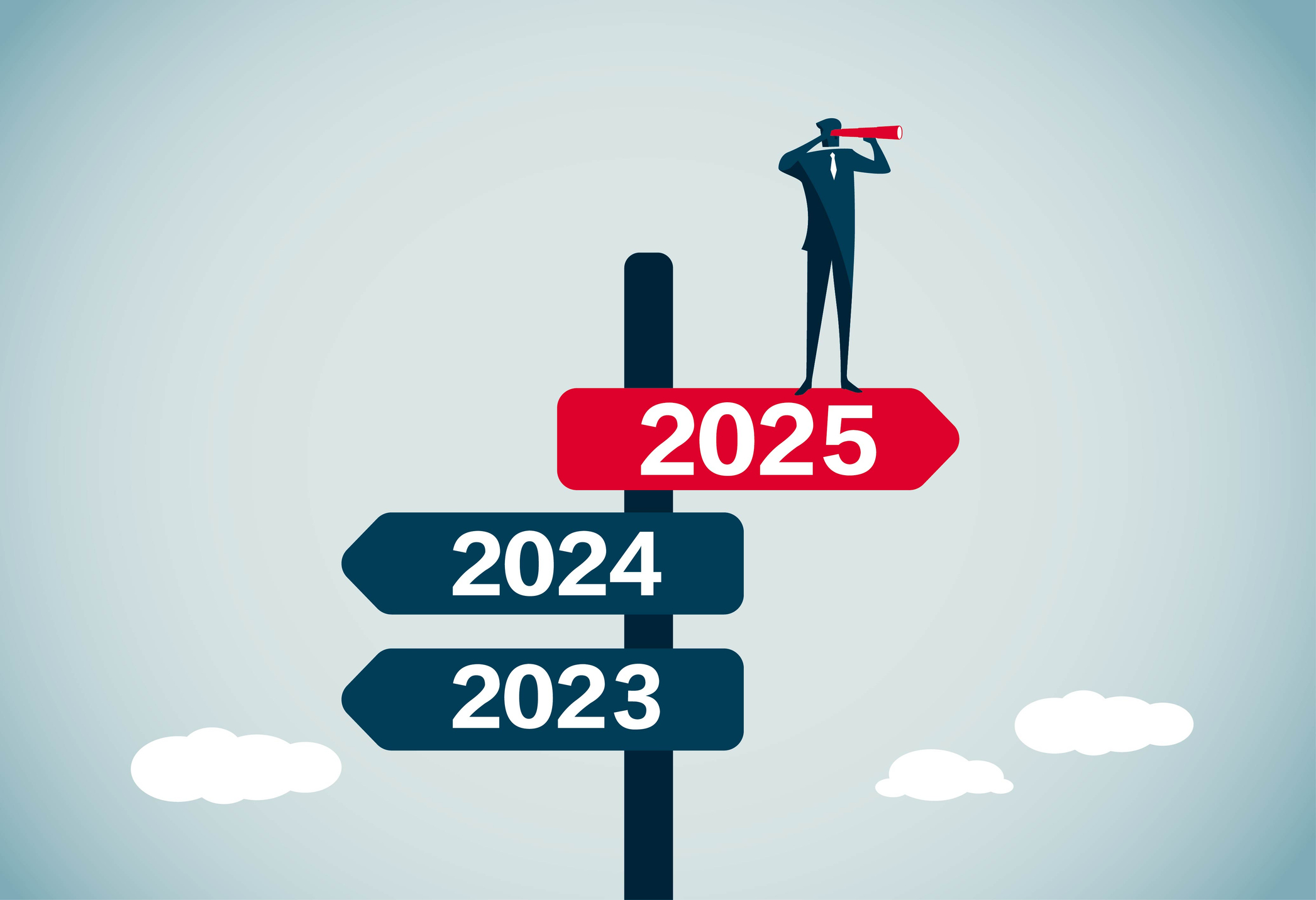U.S. Debt on Course to Balloon Before It Shrinks: Kiplinger Economic Forecasts
The nation's debt is affected by factors such as inflation, Medicare, and Social Security spending.


To help you understand what is going on in the U.S. economy and what we expect to happen in the future, our highly-experienced Kiplinger Letter team will keep you abreast of the latest developments and forecasts (Get a free issue of The Kiplinger Letter or subscribe). You'll get all the latest news first by subscribing, but we will publish many (but not all) of the forecasts a few days afterward online. Here’s the latest...
Congress just passed a deal averting one fiscal crisis. But the government’s long-term outlook is little changed: Daunting. Decades of deficit spending have added up to a national debt exceeding $25.8 trillion. And now, interest rates are climbing, which makes servicing that debt harder. Meanwhile, demographic trends mean that Washington’s retirement and healthcare outlays will only mount in the coming years. Let’s take a look at the rising tide of red ink and ask how it might be stemmed. Also, what will be the economic implications?
The outlook for national debt
Even with the cuts to planned spending in the budget ceiling deal, Washington is still spending well beyond its means. Annual deficits — the gap between tax revenues and spending — will likely come in at 5.7% of GDP in 2025 when the deal Congress and the president just made expires. In dollars, that’s $1.6 trillion. By then, the national debt will be $29 trillion and climbing. (And that figure doesn’t include debt the Treasury owes to other federal agencies, such as the Social Security Admin. We’ll add those obligations as we look ahead.)

Sign up for Kiplinger’s Free E-Newsletters
Profit and prosper with the best of expert advice on investing, taxes, retirement, personal finance and more - straight to your e-mail.
Profit and prosper with the best of expert advice - straight to your e-mail.
In theory, the deficit should start to shrink after 2025. Some tax cuts are set to expire, along with some federal subsidies that pay for health insurance under the Affordable Care Act (also known as Obamacare). But the fact is, it’ll be hard, politically, for Congress to let taxes rise or spending fall, even if prior Congresses created expiration dates for those programs. In reality, there’s a good chance that those deficit-cutting measures won’t fully kick in.
Before long, spending on entitlement programs will further hike the deficit. Medicare spending is on track to accelerate around 2028, when the bulk of baby boomers will be eligible for the program. Social Security costs will ramp up around that time as well, though the increase won’t be quite as steep.
Right now, spending on Medicare, Social Security and other entitlements costs 14% of GDP, vs just 7% for all other federal programs: defense, R&D, education, highways, etc. In 2032, entitlements’ share of output will rise to 15%. In 2038: 16%. By midcentury, they’ll eat up 17%.
And now there is a new factor driving up federal debt: Soaring interest costs. After about 15 years of low rates, borrowing costs are starting to pinch for Uncle Sam. They’re not high by historical standards, but even so, the extra expense is significant. Before the rate hikes the Federal Reserve began to implement early last year, interest on the national debt cost about 1.9% of GDP. By 2028, that cost will grow by more than half, to 3% of total output, and will keep rising if nothing is done.
Add it all up, and the national debt is on course to balloon. Next year, it’ll be equivalent to the nation’s entire GDP, and then rise to 110% of GDP by 2030. After that, the situation really gets out of control: Debt is on track to hit 140% of annual output by 2040, and a whopping 180% by the middle of the century.
The cost of rising debt
If all of these figures sound too abstract, let’s consider the real-world effects of Uncle Sam’s debt rising at such a rapid clip. The numbers get so large that it’s hard to keep sight of their practical meaning.
Start with entitlement programs: Social Security is on schedule to exhaust its assets in 2033. (Those assets are an accounting notion, not real dollars. They show how much money socked away the program would have if the Treasury hadn’t spent surplus revenue on other things in earlier years.) Legally, once the program uses up its assets, it must cut benefits by 20%. Or, to avoid benefit cuts, Social Security taxes would need to rise from 12.4% (including the employer’s share) to 15.7%. Or, bump up the rate by one percentage point and then apply it to all wages, throwing out the ceiling that kicks in at $160,200. Whatever the solution future lawmakers choose, it’ll be politically painful: A mix of higher taxes, less generous benefits, a higher retirement age, etc. Medicare Part A is in a similar situation, with the Medicare Trust Fund on tap to run out in 2031. If taxes aren’t raised to cover the gap, benefits will fall by 11%.
The U.S. is better able to bear such a heavy debt load than most nations are. It issues the world’s reserve currency. Treasuries and dollars are always in demand. But even the U.S. risks negative economic consequences as its debt rises. The cost of servicing the Treasury’s obligations will crimp other spending, such as defense or domestic programs — a worry for both Republicans and Democrats. More money going into Treasuries will also cut into private investment. There is only so much capital to go around. If the Treasury market soaks up more, that leaves less for investment in everything else, from stocks to capital equipment.
Strategies to reduce the debt burden
The politicians of the late 2020s are going to struggle with these problems. Cutting spending is unpopular. So is raising taxes. Members of both parties would like to spend more, not less (more on social programs, some Democrats say; more on the military, some Republicans counter). Democrats tend to favor tax hikes, but only on the wealthy, which Republicans oppose. Whatever your personal views, it’s not hard to see how contentious these fights will be, and how hard it will be to find compromises on raising revenue or reducing spending to manage the debt. We as a country are living beyond our means. Eventually, something will give.
There’s one other way to lessen the debt burden, without raising taxes or cutting spending. A strategy that indebted governments have resorted to before: Letting inflation slowly reduce the real value of the debt. Repaying in dollars that buy less in the future than they do now would let the feds avoid hard choices about taxing or spending. But inflation is a sort of tax that everyone has to bear, as consumers have been reminded over the past couple of years of rising prices.
The Federal Reserve is going to find itself in a bind. Controlling inflation requires being willing to hike interest rates, as the Fed is doing now. But, higher rates will make the government’s debt burden even heavier, whereas tolerating inflation would lighten it. The future Fed is going to have to decide whether to stick to its guns or take the politically easy way out, something future politicians may lobby it to do.
We think the future Fed will stick to keeping inflation under control. But it’ll have its work cut out if government spending remains well ahead of revenues, as seems likely. Inflation may prove more stubborn in the coming decade than the Fed is hoping, something for investors and savers to guard against.
This forecast first appeared in The Kiplinger Letter, which has been running since 1923 and is a collection of concise weekly forecasts on business and economic trends, as well as what to expect from Washington, to help you understand what’s coming up to make the most of your investments and your money. Subscribe to The Kiplinger Letter.
Read more
- Kiplinger's Inflation Outlook
- Kiplinger's GDP Outlook
- How the Debt Ceiling Impacts Your Finances
- Debt Ceiling Crisis: What the Experts Are Saying
Get Kiplinger Today newsletter — free
Profit and prosper with the best of Kiplinger's advice on investing, taxes, retirement, personal finance and much more. Delivered daily. Enter your email in the box and click Sign Me Up.

David is both staff economist and reporter for The Kiplinger Letter, overseeing Kiplinger forecasts for the U.S. and world economies. Previously, he was senior principal economist in the Center for Forecasting and Modeling at IHS/GlobalInsight, and an economist in the Chief Economist's Office of the U.S. Department of Commerce. David has co-written weekly reports on economic conditions since 1992, and has forecasted GDP and its components since 1995, beating the Blue Chip Indicators forecasts two-thirds of the time. David is a Certified Business Economist as recognized by the National Association for Business Economics. He has two master's degrees and is ABD in economics from the University of North Carolina at Chapel Hill.
-
 6 Stunning Waterfront Homes for Sale Around the US
6 Stunning Waterfront Homes for Sale Around the USFrom private peninsulas to lakes, bayous and beyond, Kiplinger's "Listed" series brings you another selection of dream homes for sale on the waterfront.
By Charlotte Gorbold Published
-
 Six Reasons to Disinherit Someone and How to Do It
Six Reasons to Disinherit Someone and How to Do ItWhether you're navigating a second marriage, dealing with an estranged relative or leaving your assets to charity, there are reasons to disinherit someone. Here's how.
By Donna LeValley Published
-
 What DOGE is Doing Now
What DOGE is Doing NowThe Kiplinger Letter As Musk's DOGE pursues its ambitious agenda, uncertainty and legal challenges are mounting — causing frustration for Trump.
By Matthew Housiaux Published
-
 A Move Away From Free Trade
A Move Away From Free TradeThe Letter President Trump says long-term gain will be worth short-term pain, but the pain could be significant this year.
By David Payne Published
-
 Trump’s Whirlwind Month of Crypto Moves
Trump’s Whirlwind Month of Crypto MovesThe Kiplinger Letter The Trump administration wants to strengthen U.S. leadership in the cryptocurrency industry by providing regulatory clarity.
By Rodrigo Sermeño Published
-
 What Could Derail the Economy This Year?
What Could Derail the Economy This Year?The Letter While the outlook for the U.S. economy is mostly favorable, there are plenty of risks that bear watching.
By David Payne Published
-
 Three Ways President Trump Could Impact the Economy
Three Ways President Trump Could Impact the EconomyThe Letter Some of Trump's top priorities could boost economic growth, but others risk fueling inflation.
By David Payne Published
-
 10 Predictions for 2025 from The Kiplinger Letter
10 Predictions for 2025 from The Kiplinger LetterThe Kiplinger Letter As 2025 arrives, here are our top 10 forecasts for the new year.
By Letter Editors Published
-
 Europe Faces Economic and Political Headwinds Next Year
Europe Faces Economic and Political Headwinds Next YearThe Letter Challenges for Europe: Potential tariffs, high energy prices and more competition from China will weigh on the bloc in 2025.
By Rodrigo Sermeño Published
-
 Don't Sleep on Japan's Economic Transformation
Don't Sleep on Japan's Economic TransformationThe Letter After almost three lost decades, Japan — one of the world's biggest economies — is finally showing signs of life.
By Rodrigo Sermeño Published